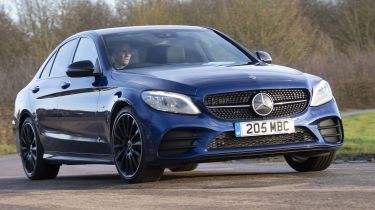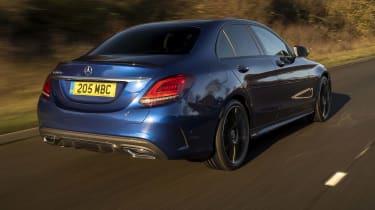Mercedes C-Class hybrid saloon (2019-2021) review
The Mercedes C 300 hybrid is the only model in its sector with the option of diesel-electric power – and it's a great combination

Pros
- Available as a diesel-electric hybrid
- Efficient with good electric range
- Refined and comfortable
Cons
- Expensive to buy
- Some rivals offer better value
- Estate version is more versatile
| Car type | Electric range | Fuel economy | CO2 emissions |
|---|---|---|---|
| Plug-in hybrid | 34-35 miles | 177-235mpg | 31-34g/km |
Plug-in hybrid powertrains in mid-size saloons have become increasingly popular in recent years, particularly among company-car users. The Mercedes C-Class has been available in plug-in hybrid form since 2019 and faces competition from the BMW 330e, Volvo S60 Recharge and Volkswagen Passat GTE, in addition to newcomers like the recently unveiled DS 9 E-TENSE.
There's a new C-Class on the way, and it'll also be available as a plug-in hybrid. In the meantime, where the current C-Class plug-in hybrid stands out is its unique combination of diesel and electric power opposed to the petrol-electric powertrains in its competitors. A petrol-electric C 300 e is available, but it can’t compete with its diesel counterpart in terms of economy or emissions – although the petrol version could be better for lower-mileage drivers.
The C 300 de is aimed at people who do a mix of local, urban driving and big motorway runs. It aims to combine the traditional smooth, long-distance cruising ability of a powerful diesel engine with the sprightly around-town performance and zero-emissions capability of electric power.
Both C 300 e and C 300 de are offered in four-door saloon and five-door estate bodystyles, but here we're reviewing the saloon. The extensive trim line-up includes Sport, AMG Line, AMG Line Night Edition Premium and AMG Line Night Edition Premium Plus, ranging in price from just under £41,000 to just over £50,000. Depending on what standard equipment you prioritise, the BMW 330e could offer better value for private buyers, but it's unlikely that those in the company-car user-chooser market will notice much difference.
The Mercedes C-Class has always been a less sporty proposition than its rivals from BMW and Audi; its plug-in hybrid drivetrain improves refinement, especially at lower speeds where a standalone diesel engine can be a bit clattery. The C 300 de is faster than an equivalent non-electrified model, too, with lots of low-down torque helping to cut the 0-62mph time to 5.6 seconds.
Despite the car's extra weight – some 310kg in the diesel – the C 300 de rides well and is very comfortable and cosseting. Non-electrified C-Class models feel lighter on their toes, but the plug-in car still handles neatly enough. It stops short of being as engaging for a keen driver as a 3 Series, however. Inside, the C-Class' interior is starting to feel a bit old, but has been fitted with Mercedes' latest infotainment system and – in higher-spec models – plenty of equipment.
Overall, the C-Class is another competitive entry into the hotly contested plug-in hybrid compact executive class. Its unique selling point is the option of electrified diesel power, offering company-car drivers something a little more useful for when their battery runs flat on a longer run. It could well be a clincher for many. For a more in-depth look at the C-Class hybrid in both its forms, see the rest of our review...



